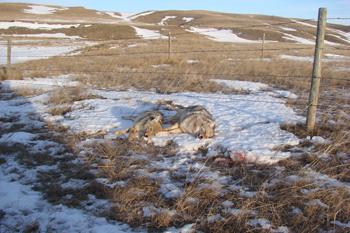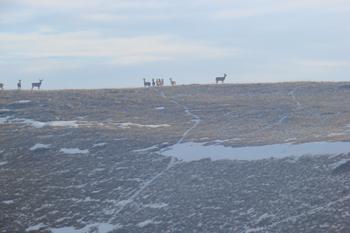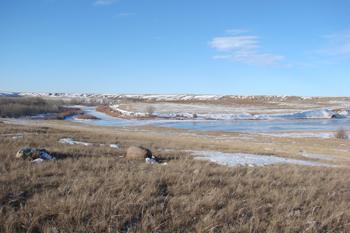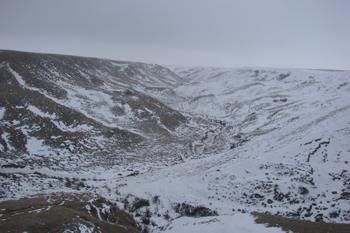Coyote Stealth
By Ted J. Haynes
You are at your stand. The coyote is coming. You're ready, and the wind is in your face, well concealed. 700 yards, 600 yards, but then all you see is a tail going the other way. Unfortunately, this has happened to me more than just a few times.

Stealth is very important in getting to the stand. Whether you walk, crawl, or get dropped off, your attack needs to be planned.
My friend and long time mentor, Randy (I really think he was calling coyotes just after the March West), talked about this particular problem on several occasions. With the e-caller and all the DVD's available, with all the information on coyote calling, how can a person go wrong? Looking back, the mistake often happens the moment the truck is started. A coyote can hear better, see better, and smell better than any human. (Then again, some coyotes smell better than many individuals I have met.) The truck, or whatever mode of transport is used to get to the stand, has on many occasions already alerted Mr. Coyote.
This is not always the case, as I stated in last month's article. But if you have not seen it happen yet, you need to hunt more. For some reason, many coyotes hear a vehicle and are gone, while others seem oblivious to them. I have noticed this at this one location where a rancher has deposited his dead animals. There will be several coyotes feeding there. When you get within three miles, many are on a dead run away from the pile, while others stay put. The coyotes staying there are of mixed ages. It is not just the older coyotes that will always flee.

This winter I went to one of my usual calling locations, parked the truck well back and walked. I got in position and began calling. Then I heard the howls, but not where I had expected. Nearly every time that I had called from near this location previously, the coyotes were in the bottom of the coulee. Today they were across and up near the top of the coulee. The other side was higher and soon the howls turned into barks. I went through my whole bag of tricks. That coyote wanted to come, but was not going to move. Dejectedly I walked back to the truck, got in and looked across to the east ridge of the coulee, which was visible, which meant the coyote could see the truck as well. My only consolation was that you can only walk so far.
On another occasion this winter, I parked my truck and began the mile walk to the stand. My size 11 1/2's breaking through the snow with a loud crunch, I slowly picked my way along, staying behind the sand dunes and down low. There was one coyote I could see a couple miles to the west. It was just walking and was not spooked. As I neared my stand there were two coyotes sitting on the dunes. The sagebrush was keeping their eyes from seeing me. My rangefinder showed 210 yards. Boom! One down. There was a quick pup squeal and the other coyote stopped. Boom! Two down. I still did call from the stand. Some coyotes howled, but none would come in. This time vehicle location and stealth paid off.
Southern Alberta does not have a lot of bush. I use whatever the location has to offer to try and conceal my vehicle. One of the best methods that has worked is to have a partner, and to take turns parking the vehicle. My partner had dropped me off and the snow was close to 12 inches deep. I let him get out of sight and began calling. Within five minutes a coyote was walking down the trail my partner had left. I thanked my partner for that. 80 yard shots are not often missed.

Then you have the coyote that sees the vehicle and keeps on doing what he is doing. I am very conscious of watching the coyotes' body language. Is it just walking, searching for food or on the run to the next county? When I see a coyote that is walking and/or hunting, I know there is a chance to call it in. This situation happened a couple weeks ago. The coyote was out hunting in a field approximately 500 yards from the road, not the least concerned about vehicles. I went to the next road in, down two miles and then walked in. I got to the possible location and looked back. The truck was still visible. I walked to another hill, really a knob, and looked back. The truck was not visible to me. I then began to call, and 10 minutes later the hunt was concluded by dragging back a large male coyote.

Whatever means and mode of transport is used to get to the stand should be considered when calling. The percentage of coyotes that is willing to risk seeing a vehicle and still come in is very low.
Another time, I parked my vehicle in a well concealed spot. On the way to the stand I bumped a coyote that was headed to the coulee. At this point I was not going to turn back, and went to the stand location. I began to call, using cat call. The coyote reappeared about 600 yards out and started heading back, then stopped at 481 yards. This time I was not really confident the coyote would come in. The wind had changed and was now blowing out towards the coyote. For some unknown reason the coyote stopped and laid down. A couple more cat squeals and some mouse squeaks, and another coyote was coming in from the same direction. That coyote stopped to visit the other one then kept coming. At 381 yards, body language was indicating the game was up. The first coyote was down, and I just missed the second one as it neared the crest of the hill.
In coyote hunting, always remember: concealment, stealth and persistence need to be considered as much as calling.
By Ted J. Haynes
You are at your stand. The coyote is coming. You're ready, and the wind is in your face, well concealed. 700 yards, 600 yards, but then all you see is a tail going the other way. Unfortunately, this has happened to me more than just a few times.

Stealth is very important in getting to the stand. Whether you walk, crawl, or get dropped off, your attack needs to be planned.
My friend and long time mentor, Randy (I really think he was calling coyotes just after the March West), talked about this particular problem on several occasions. With the e-caller and all the DVD's available, with all the information on coyote calling, how can a person go wrong? Looking back, the mistake often happens the moment the truck is started. A coyote can hear better, see better, and smell better than any human. (Then again, some coyotes smell better than many individuals I have met.) The truck, or whatever mode of transport is used to get to the stand, has on many occasions already alerted Mr. Coyote.
This is not always the case, as I stated in last month's article. But if you have not seen it happen yet, you need to hunt more. For some reason, many coyotes hear a vehicle and are gone, while others seem oblivious to them. I have noticed this at this one location where a rancher has deposited his dead animals. There will be several coyotes feeding there. When you get within three miles, many are on a dead run away from the pile, while others stay put. The coyotes staying there are of mixed ages. It is not just the older coyotes that will always flee.

This winter I went to one of my usual calling locations, parked the truck well back and walked. I got in position and began calling. Then I heard the howls, but not where I had expected. Nearly every time that I had called from near this location previously, the coyotes were in the bottom of the coulee. Today they were across and up near the top of the coulee. The other side was higher and soon the howls turned into barks. I went through my whole bag of tricks. That coyote wanted to come, but was not going to move. Dejectedly I walked back to the truck, got in and looked across to the east ridge of the coulee, which was visible, which meant the coyote could see the truck as well. My only consolation was that you can only walk so far.
On another occasion this winter, I parked my truck and began the mile walk to the stand. My size 11 1/2's breaking through the snow with a loud crunch, I slowly picked my way along, staying behind the sand dunes and down low. There was one coyote I could see a couple miles to the west. It was just walking and was not spooked. As I neared my stand there were two coyotes sitting on the dunes. The sagebrush was keeping their eyes from seeing me. My rangefinder showed 210 yards. Boom! One down. There was a quick pup squeal and the other coyote stopped. Boom! Two down. I still did call from the stand. Some coyotes howled, but none would come in. This time vehicle location and stealth paid off.
Southern Alberta does not have a lot of bush. I use whatever the location has to offer to try and conceal my vehicle. One of the best methods that has worked is to have a partner, and to take turns parking the vehicle. My partner had dropped me off and the snow was close to 12 inches deep. I let him get out of sight and began calling. Within five minutes a coyote was walking down the trail my partner had left. I thanked my partner for that. 80 yard shots are not often missed.

Then you have the coyote that sees the vehicle and keeps on doing what he is doing. I am very conscious of watching the coyotes' body language. Is it just walking, searching for food or on the run to the next county? When I see a coyote that is walking and/or hunting, I know there is a chance to call it in. This situation happened a couple weeks ago. The coyote was out hunting in a field approximately 500 yards from the road, not the least concerned about vehicles. I went to the next road in, down two miles and then walked in. I got to the possible location and looked back. The truck was still visible. I walked to another hill, really a knob, and looked back. The truck was not visible to me. I then began to call, and 10 minutes later the hunt was concluded by dragging back a large male coyote.

Whatever means and mode of transport is used to get to the stand should be considered when calling. The percentage of coyotes that is willing to risk seeing a vehicle and still come in is very low.
Another time, I parked my vehicle in a well concealed spot. On the way to the stand I bumped a coyote that was headed to the coulee. At this point I was not going to turn back, and went to the stand location. I began to call, using cat call. The coyote reappeared about 600 yards out and started heading back, then stopped at 481 yards. This time I was not really confident the coyote would come in. The wind had changed and was now blowing out towards the coyote. For some unknown reason the coyote stopped and laid down. A couple more cat squeals and some mouse squeaks, and another coyote was coming in from the same direction. That coyote stopped to visit the other one then kept coming. At 381 yards, body language was indicating the game was up. The first coyote was down, and I just missed the second one as it neared the crest of the hill.
In coyote hunting, always remember: concealment, stealth and persistence need to be considered as much as calling.

